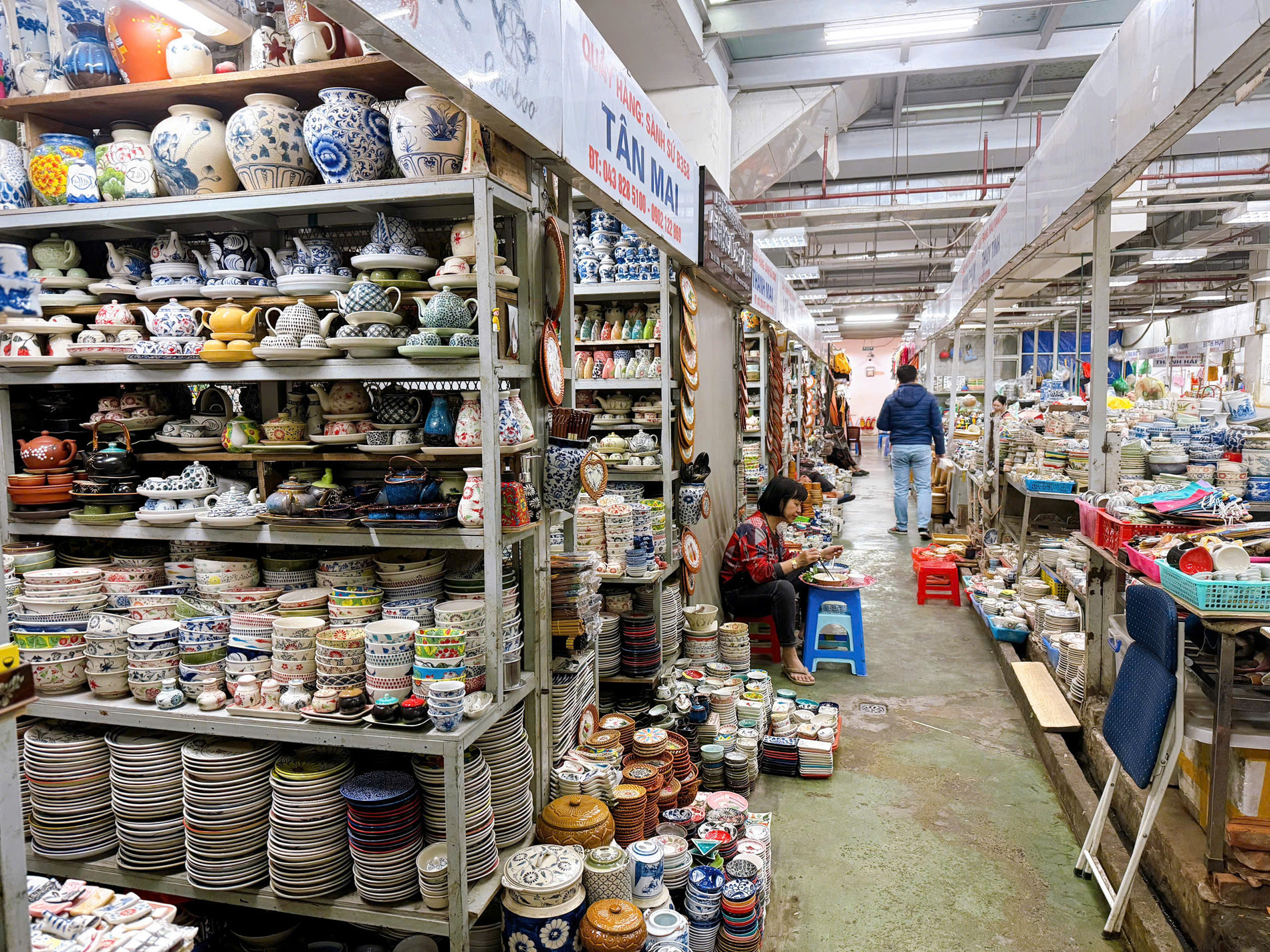
Hang Da Market, one of Hanoi’s oldest and most famous traditional markets, had multiple entrances in the past facing the streets of Nguyen Van To, Hang Da, and Ngo Tram Alley. It was divided into four main sections: one for fresh produce, one for food and drinks, one for clothing, and another for miscellaneous goods.
Stepping into the market, visitors were greeted by rows of stalls packed closely together, offering a wide variety of items, earning it the nickname "shopping paradise" of its time.
In 2010, Hang Da Market was renovated into a modern Hang Da shopping center of five stories and two basements. The market area is now located in the basement, which is why locals and tourists call it the "underground market."
Inside Hang Da Market, a diverse range of goods is still available, organized into distinct sections such as dried goods, fresh food, clothing, fabrics, souvenirs and more.
The stalls selling ceramics and handicrafts are especially popular with foreign tourists, who come to admire and shop for these items.
According to vendors, daily shoppers are more scarce than in the past, with most visitors being tourists exploring and browsing souvenirs.
They attribute this to the inconvenience of accessing the market: people must park their vehicles and descend to the basement. Additionally, the surrounding area now has many temporary markets and vendors selling all sorts of goods.
"The market’s layout isn’t convenient; the entrance is tucked away and hard to find. Being in the basement, the enclosed space feels stuffy and cramped to many.

"Both tourists and locals struggle to find parking, and the parking lot is often full, so over time, people grow weary and lose interest in coming here," a vendor lamented.
However, the food section at Hang Da Market remains a beloved spot for many diners, especially around lunchtime.
Though its space and scale are modest compared to the food areas of other traditional markets, with just under a dozen stalls, the dishes are varied and delicious.
For a filling meal, visitors can enjoy hot dishes like com suat (rice with food), bun rieu cua (crab noodle soup), pho ga (chicken pho), bun thang (noodles in chicken broth), mien luon (eel noodles), chao (porridge), bun bo (vermicelli with beef), xoi (steamed sticky rice), mi xao (stir-fried noodles) and bun gia cay (fake dog meat and vermicelli).
There are also snacks and treats available, such as mien tron (mixed noodles), pho xa xiu (char siu pho), goi cuon (fresh spring rolls), nom bo kho (dried beef salad), sweet soup, and refreshing drinks.
Diners who’ve visited HangDa Market note that the food is quite diverse, catering to a wide range of tastes and age groups.
Each dish is sold at affordable prices, ranging from VND20,000 to VND40,000.
With VND100,000, tourists can enjoy 2-3 different dishes at Hang Da Market. For example, eel noodles cost VND35,000, chicken pho VND35,000, and black bean porridge VND20,000.
Ayumu, a tourist from Japan, shared that she had visited Hang Da Market twice.
Enjoying collecting items and exploring Southeast Asian culture, Ayumu came to the market to shop for colorful, patterned goods like cups and plates.
The Japanese tourist visited the food section and tried mien luon (eel noodles), priced at VND35,000, pho ga (noodles served with chicken) at VND35,000 and chao do den (black bean porridge) at VND20,000.
"Compared to other traditional markets in Hanoi I’ve been to, like Mo Market or Dong Xuan Market, the dining space here is narrower, and there are fewer options to choose from. However, I found the food here unique and reasonably priced, making it worth a visit," Ayumu said.
There is another ‘underground market’ in Hanoi called ‘Mo Market’, which is also one of the long lasting markets in the capital city.
In the past, the market was located at the southern gateway of the ancient Thang Long citadel, operating on a periodic schedule with six market days per month—on the 2nd, 12th, 22nd, and the 7th, 17th, 27th of the lunar calendar.
In 2014, the Mo Market Shopping Center was built, situated at the intersection of Bach Mai and Minh Khai streets in Hai Ba Trung District.
The market itself is arranged in the basement of the center. For this reason, locals refer to it as the "underground market" of the capital.
Thao Trinh